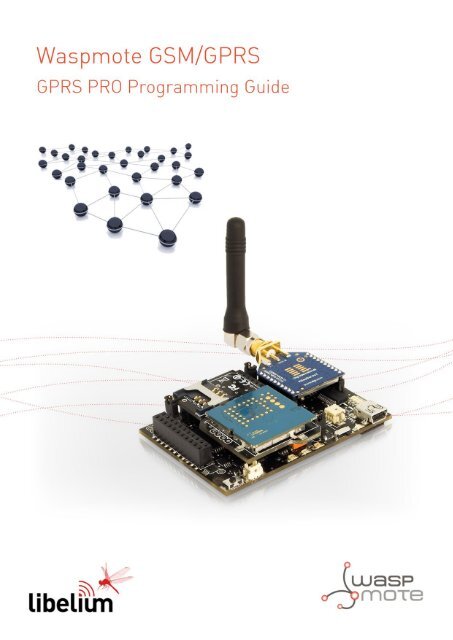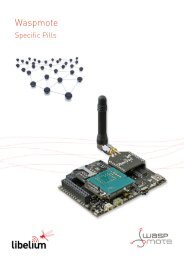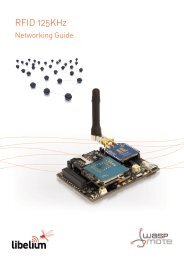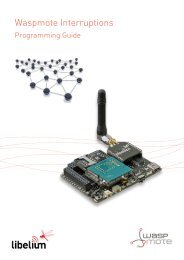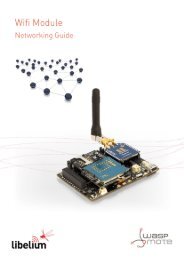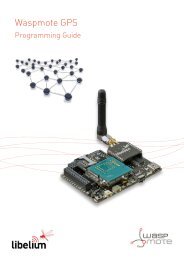Create successful ePaper yourself
Turn your PDF publications into a flip-book with our unique Google optimized e-Paper software.
Index11. API Changelog.................................................................................................................................. 3412. Documentation changelog.............................................................................................................. 38Appendix 1: CME error codes................................................................................................................ 39Appendix 2: CMS error codes................................................................................................................ 40-4- v0.5
General Considerations1. General Considerations1.1. Differences between“GPRS” and“GPRS PRO” libraries forWaspmoteGPRS libraries were developed to control the Hilo module (from Sagem). The GPRS_Pro libraries had been developed to controlthe new GPRS board which integrates the SIM900 module (from SIMCom). GPRS_Pro performs the same actions that GPRSmodule (some functions had been enhanced) and new functions has been added such as multiconnection for TCP/IP and UDP/IP clients, audio control or operator selection.Regarding power consumption it has been reduced from 56μA to 30μA in power down mode (GPRS_OFF power mode).The SIM900 module im<strong>pr</strong>oves TCP/IP and UDP/IP connections adding new features such as TCP/IP server and multiconnectionmode that allows up to 8 TCP/UDP clients or up to 7 TCP/UDP clients and 1 TCP/IP server. Extra functions such as autosendingtimer, add IP headers, setting DNS servers,... have been added.Also uploading and downloading functions have been upgraded to allow to select the origin and destiny folder into the SD cardand FTP server.New functions allow to manage speaker level, Calling Line Identification (CLI) , mute, call alert. Also GSM/GPRS operatorconnection can be managed with functions such as get current operator, set <strong>pr</strong>eferred operator list, get cell information.1.2. HardwareFigure 1: GSM/GPRS moduleModel: SIM900 (SIMCom)Quadband: 850MHz/900MHz/1800MHz/1900MHzTX Power: 2W (Class 4) 850MHz/900MHz, 1W (Class 1) 1800MHz/1900MHzSensitivity: -109dBmAntenna connector: UFLExternal Antenna: 0dBiConsumption in power down mode: 30µA-6- v0.5
General ConsiderationsActions:••Making/Receiving calls.••Making ‘x’ tone missed calls.••Sending/Receiving SMS.••Single connection and multiple connections TCP/IP and UDP/IP clients.••TCP/IP server.••HTTP service.••FTP service (downloading and uploading files).Figure 2: GSM/GPRS module in Waspmote1.3. Waspmote Libraries1.3.1. Waspmote GPRS_Pro FilesWaspGPRS_Pro.h ; WaspGPRS_Pro.cpp1.3.2. ConstructorIn order to start using Waspmote GPRS_Pro library, an object from class ‘WaspGPRS_Pro’ must be created. This object, called‘GPRS_Pro’, is created inside Waspmote GPRS_Pro library and it is public to all libraries. It is used throughout the guide to showhow the Waspmote GPRS_Pro library works.When creating this constructor, some variables are defined with a value by default, that can be modified later. These variables are:••baudRate : specifies the baudrate used to communicate with the module (38400 by default).••_socket : specifies the socket used to communicate with the module (UART1 by default).••_pwrMode : specifies the power mode (ON by default).-7- v0.5
General Considerations1.3.3. Working ModesSome constants have been defined to set the different working modes for GPRS_Pro module.••0: GPRS_PRO_ON. Module is powered on. Starts in full funtionality mode.••1: GPRS_PRO_FULL. Module is set in full functionality (power consumption around 10-40mA).••2: GPRS_PRO_RF_OFF. Module deactivates RF circuits (power consumption around 10-40mA).••3: GPRS_PRO_MIN. Module is set on minimum functionality (power consumption around 10-40mA).••4: GPRS_PRO_SLEEP. Module enters in sleep mode when there is no data on serial port. From time to time, it communicateswith carrier to maintain the connection (power consumption 1-2mA ).••5: GPRS_PRO_POWER_OFF. Module is powered off. The power transistors are switched off.Minimum functionality mode and RF disabled functionality mode cannot be switched to each other. When the modulecommunicates with carrier, current peaks between 1-1’4A are <strong>pr</strong>oduced.1.3.4. Library fusesThe library for this module is divided in 4 sections and a section with functions and constants that always are active. Eachsection is activated/deactivated by a fuse. This fuses are located in WaspGPRS_Pro.h. By default this fuses have a ‘1’ allowing touse the functions. The WaspGPRS_Pro.h have this fuses:••GSM_FUSE: Call and SMS related funtions and constants••HTTP_FUSE: HTTP related funtions and constants••FTP_FUSE: FTP related funtions and constants••IP_FUSE: TCP and UDP related funtions and constantsFor deactivate a section change the ‘1’ in the related fuse by ‘0’.Note: If you use a function with the related fused with a value of ‘0’, the compiler will give you an error. Please, be carefully using thefuses when compiling.1.3.5. Debug modesThe library have two debug modes implemented that allows to the experimented user show the data transmitted and receivedbetween the Waspmote and the GPRS_Pro module. The value of the GRPS_debug_mode constant selects the debug mode:••‘0’ Disables all debug messages••‘1’ Shows only the commands sent to the GPRS_Pro module and some extra messages••‘2’ Shows commands sent to the GPRS_Pro module, the data answered by the module and some extra messagesThe constant GPRS_debug_mode is located in WaspGPRS_Pro.h file.1.3.6. Special errorsSome functions can give an extra error code (CME or CMS error codes).This code is stored on GPRS_Pro.CME_CMS_code . To know the description of the code see the apendix.-8- v0.5
Initialization2. Initialization2.1. Initializing the GPRS_Pro moduleThe GPRS_Pro module is connected to a multiplexer, since it is connected to the same microcontroller socket. To start using theGPRS_Pro module, this multiplexer must be switched on and choose the correct combination for the GPRS_Pro to be selected.To open the socket and set the multiplexer to the correct combination, a function has been developed. This function powers onthe module too.Example of use:{}GPRS_Pro.ON(); // Opens socket and sets multiplexer2.2. Setting the GPRS_Pro Power ModeSets the current internal Power Mode on the GPRS_Pro. GPRS_Pro module has five different power modes: GPRS_PRO_ON,GPRS_PRO_FULL, GPRS_PRO_RF_OFF, GPRS_PRO_MIN, GPRS_PRO_SLEEP, GPRS_PRO_POWER_OFF. The function will setup the pwrMode variable to one of the five values, but also sends the serial command to the GPRS_Pro module. It returns ‘1’ onsuccess, ‘0’ and ‘-2’ if error and ‘-3’ when the module starts succesfully with low battery.Example of use:{}uint8_t powerMode = 0;GPRS_Pro.setMode(GPRS_PRO_ON); // Powers GPRS_Pro onpowerMode = GPRS_Pro.getMode(); // Get GPRS_Pro power modeRelated variablesGPRS_Pro.pwrMode stores GPRS_Pro power mode2.3. Closing the GPRS_Pro moduleIt closes the socket to which the GPRS_Pro module is connected. It means disconnecting the internal socket drivers inside theATMEGA1281 <strong>pr</strong>ocessor.Example of use:{}GPRS_Pro.close(); // Closes socket2.4. Switching GPRS_Pro offIt closes the socket to which the GPRS_Pro module is connected to and turns it off.Example of use:{}GPRS_Pro.OFF(); // Closes socket and turns it off-9- v0.5
Initialization2.5. Setting time and dateThis function updates the time and the date of the GPRS_Pro module from the RTC.It returns ‘1’ on success , ‘0’ or ‘-2’ if errorExample of use:{}GPRS_Pro.setTime(); // Updates time and date2.6. Checking the GSM connectionIt checks if the module is connected to the network for a time desired by the input parameter.If the GPRS_Pro module does not connect within these attempts, function exits with ‘0’.It returns ‘1’ when connected and ‘0’ if not.Example of use:{}GPRS_Pro.check(180); // Waits 180 seconds for connectionAccording to <strong>Libelium</strong> experience, 180 seconds is the recommended timeout for connecting the GPRS network. The timeoutmay vary depending on the network range and quality of service. If the user detects this timeout does not allow his GPRS toconnect, he can experiment with higher values. 180 seconds would be the maximum advised timeout: if the GSM/GPRS modulecannot connect in 2 minutes, it is better to stop trying and check again in the next loop.-10- v0.5
SIM related functions3. SIM related functionsSome functions have been developed to configure some settings related with GSM, specifically with managing calls and SMS.3.1. Setting the PINIt sets the PIN to the SIM and it returns ‘1’ on success, ‘0’ if error and ‘-2’ if CME error code available.Example of use{}GPRS_Pro.setPIN(“1234”);// Sets PIN = 1234 to the SIM3.2. Changing PIN numberIt changes PIN number of SIM card.It returns ‘1’ on success, ‘0’ if error and ‘-2’ if CME error code available.Example of use{GPRS_Pro.changePIN(“1234”, “4321”); // Changes “1234” to “4321” PIN number}3.3. Getting IMSIIt gets the IMSI from the SIM card and it stores the IMSI into buffer_GPRS variable.It returns ‘1’ if connected, ‘0’ if not.Example of use{GPRS_Pro.getIMSI();}3.4. Getting IMEIIt gets the IMEI from the SIM card and it stores the IMEI into buffer_GPRS variable.It returns ‘1’ if connected, ‘0’ if not.Example of use{}GPRS_Pro.getIMEI();-11- v0.5
Call functions4. Call functions4.1. Setting Information returned when receiving a callThis function configures the information returned by the module when a call is received. It is useful to generate interruptions orto store data from the incoming call .It returns ‘1’ on success, ‘0’ if error and ‘-1’ if no memory and ‘-2’ if error with CME error code available.Example of use{}GPRS_Pro.setInfoIncomingCall(); // Sets information returned by the module when incoming call4.2. Making CallsIt makes a call to the given telephone number.It returns ‘1’ on success, ‘0’ if error.Note: the number can be using the country code or only the phone number.Example of use{}GPRS_Pro.makeCall(“*********”); // Makes a call to the desired number4.3. Making Missed CallsIt makes a specified duration missed call to the given telephone number.It returns ‘1’ on success, ‘0’ if error.Note 1: the calling time includes the time to send the request to the carrier, so the receiving call time is a bit shorter than the inputparameter.Note 2: the number can be using the country code or only the phone number.Example of use{}GPRS_Pro.makeLostCall(“*********”,10); // Makes a lost call of 10 seconds to the desired number4.4. Hanging up callsIt hangs up all the active calls. It returns ‘1’ on success and ‘0’ if error.Example of use{}GPRS_Pro.hangUp(); // Hangs all the active calls up-12- v0.5
5. SMS related functions5.1. Setting Information returned when receiving an SMSSMS related functionsThis function configure the information returned by the module when an SMS is received. It is useful to generate interruptionsor to store data from the incoming SMS.It returns ‘1’ on success and ‘0’ if error.Example of use{}GPRS_Pro.setInfoIncomingSMS(); // Sets information returned by the module when incoming SMS5.2. Setting Mode for SMSIt sets the text mode for the SMS and it returns ‘1’ on success and ‘0’ if error.It returns ‘1’ on success and ‘0’ if error.Example of use{}GPRS_Pro.setTextModeSMS(); // Sets text mode for SMS5.3. Sending SMSIt sends a SMS to the specified number.It returns ‘1’ on success, ‘0’ if error, ‘-2’ if error sending the SMS and ‘-3’ if error sending the SMS with CMS error code available.Note: the maximum length is 90 Bytes (90 characters).Example of use{}GPRS_Pro.sendSMS(“Hello World!”,“6********”); // Sends this text in an SMS to the desired number5.4. Deleting SMSIt deletes a SMS in memory selected by sms_index.It returns ‘1’ on success, ‘0’ if error and ‘-2’ if error with CMS error code available.Example of use:{}GPRS_Pro.deleteSMS(“2”); // Deletes the SMS at index 2-13- v0.5
5.5. Getting the number of total SMSs stored in the SIMIt gets the number of total SMSs stored in the SIMIt returns the number of SMSs, or ‘-2’ if errorExample of use:SMS related functions{}total_SMS = GPRS_Pro.getTotalSMS(); // Gets the number of SMS-14- v0.5
HTTP and FTP <strong>pr</strong>otocols6. HTTP and FTP <strong>pr</strong>otocols6.1. Configuring HTTP/FTP <strong>pr</strong>ofileIt configures GPRS connection with login, password and some other parameters for use with HTTP and FTP funtions.The configuration parameters from ‘WaspGPRS_Pro.h’ are AT_GPRS_APN, AT_GPRS_LOGIN and AT_GPRS_PASSW.It returns:• ‘1’ on success• ‘0’ if error• ‘-2’ if error setting the type of internet connection,• ‘-3’ if error setting the APN• ‘-4’ if error setting the user name• ‘-5’ if error setting the password• ‘-6’ if error saving the configurationExample of use:{GPRS_Pro.configureGPRS_HTTP_FTP(1); // Configures <strong>pr</strong>ofile 1 for use it}6.2. Creating your own FTP serverFirst, you should get a server. This server will receive your frames and store them. There is no need to purchase a physical serversince there a companies that offer remote servers.Note: The server used by <strong>Libelium</strong> to realize the upload and download tests is a Pure-FTPD server (www.pureftpd.org) and it ishosted into a OVH server (www.ovh.com). The Pure-FTPD server has the settings by default:••TLS encryption support: Optional••TLS cipher suite: High-Medium + TLSv1••Allow anonymous logins: No••Allow anonymous uploads: No••Maximum load for anonymous downloads: 4••Maximum idle time (minutes): 15••Maximum connections: 50••Maximum connections per IP address: 8••Allow logins with root password: Yes••Broken clients compatibility: NoFrom <strong>Libelium</strong>, we recommend the use of this server hosting <strong>pr</strong>ovider to obtain good results to upload and download files, but wecan’t guarantee the perfect performance of the FTP server.Also, <strong>Libelium</strong> has tested with Guebs hosting (www.guebs.com) with good results.-15- v0.5
HTTP and FTP <strong>pr</strong>otocolsFollow the next steps to create your own FTP server using the terminal:1 - Install the pure-ftpd server:sudo apt-get install pure-ftpd2 - Stop the server:sudo /etc/init.d/pure-ftpd stop3 - Before creating the user, it is necessary create a directory to stored the received data:sudo mkdir /home/ftp and inclide a false shell. To check if the shell exist:sudo more /etc/shells4 - If it isn’t the line /bin/false, edit the file, for example with vim, and include it:sudo vim /etc/shells5 - After creating a new folder to store data, you have to create a group and a user with false shell, because this typeof user don’t need a valid shell (more secure), therefore select /bin/false shell for user and /dev/null as directory:sudo groupadd ftpgroupsudo useradd -g ftpgroup -d /dev/null -s /bin/false user16 - Modify folder permissions:sudo chown -R user1 /home/ftpsudo chmod -R 755 /home/ftp7 - Add the new user to the pure-ftpd database:sudo pure-pw useradd username -u ftpuser -g ftpgroup -d /home/ftpSet the user password when it request.8 - Update the pure-ftpd database:sudo pure-pw mkdb9 - When the users are include in the ftp, start the server:sudo /etc/init.d/pure-ftpd startRemeber to open the ports in your router. After this, you will be able to receive FTP transmissions on your server. We advise touse FileZilla to visualize and manage your FTP server.-16- v0.5
HTTP and FTP <strong>pr</strong>otocols6.3. Uploading a fileIt uploads a file to a FTP server.It returns:• ‘1’ on success• ‘0’ if error opening connection with the GPRS <strong>pr</strong>ovider• ‘-1’ if no GPRS connection• ‘-2’ if error opening the connection• ‘-3’ if error getting the IP address• ‘-4’ if error setting the FTP/HTTP ID (no answer from module)• ‘-5’ if error setting the FTP mode (no answer from module)• ‘-6’ if error setting the FTP type (no answer from module)• ‘-7’ if error setting the FTP server(no answer from module)• ‘-8’ if error setting the FTP port (no answer from module)• ‘-9’ if error setting the user name• ‘-10’ if error setting the password• ‘-11’ if error starting the SD• ‘-12’ if error taking the file size in the SD• ‘-13’ if error setting the file name in the FTP server (no answer from module)• ‘-14’ if error setting the path of the file in the FTP server (no answer from module)• ‘-15’ if error opening the FTP session (no answer from module)• ‘-16’ if error when request to send data• ‘-17’ error sending data to the FTP• ‘-18’ if error waiting for send more data• ‘-19’ if error when setting Upload File (with CME error code available)• ‘-20’ if error closing the FTP session (no answer from module)• ‘-21’ setting the file name in the FTP to get the file size• ‘-22’ setting the path in the FTP to get the file size• ‘-23’ if error getting the file size (no answer from module)• ‘-24’ if error opening SD file• ‘-25’ if error when setting pointer to the beginning of the file• ‘-40’ if error from FTP when the module sends data with error code available• ‘-41’ if error setting the FTP/HTTP ID with CME error code available• ‘-42’ if error setting the FTP mode (with CME error code available)• ‘-43’ if error setting the FTP type (with CME error code available)• ‘-44’ if error setting the FTP server (with CME error code available)• ‘-45’ if error setting the FTP port (with CME error code available)• ‘-46’ if error setting the user name (with CME error code available)• ‘-47’ if error setting the password (with CME error code available)• ‘-48’ if error setting the file name in the FTP server (with CME error code available)-17- v0.5
HTTP and FTP <strong>pr</strong>otocols• ‘-49’ if error setting the path of the file in the FTP server (with CME error code available)• ‘-50’ if error opening the FTP session (with CME error code available)• ‘-51’ if error closing the FTP session (with CME error code available)• ‘-53’ setting the file name in the FTP to get the file size (with CME error code available)• ‘-54’ setting the path in the FTP to get the file size (with CME error code available)• ‘-55’ if error getting the file size (with CME error code available)• ‘-56’ if FTP is busy error getting the size of the file from the FTP• ‘-57’ if FTP is busy sending data• ‘-58’ if timeoutExample of use{GPRS_Pro.uploadFile(“/SD_folder/file.txt”, “/FTP_folder/test_file.txt”, “username”, “password”,“FTP_server”, “FTP_port”, 1); // Uploads file.txt file with HTTP/FTP <strong>pr</strong>ofile 1}-18- v0.5
HTTP and FTP <strong>pr</strong>otocols6.4. Downloading a fileIt downloads a file from an FTP server.It returns:‘1’ on success‘0’ if error opening connection with the GPRS <strong>pr</strong>ovider‘-1’ error downloading the file‘-2’ if error getting the IP address‘-3’ if error setting the FTP/HTTP ID‘-4’ if error setting the FTP mode‘-5’ if error setting the FTP type‘-6’ if error setting the FTP server‘-7’ if error setting the FTP port‘-8’ if error setting the user name‘-9’ if error setting the password‘-12’ if error setting the file name in the FTP server,‘-13’ if error setting the path of the file in the FTP server‘-14’ if error opening the FTP session‘-15’ if error starting the SD‘-16’ if error creating the file‘-17’ error requesting data to the FTP‘-18’ if error saving data into the SD‘-19’ if error requesting more data to the FTP‘-21’ setting the file name in the FTP to get the file size‘-22’ setting the path in the FTP to get the file size‘-23’ if error getting the file size‘-41’ if error setting the FTP/HTTP ID with CME error code available‘-42’ if error setting the FTP mode with CME error code available,‘-43’ if error setting the FTP type with CME error code available‘-44’ if error setting the FTP server with CME error code available‘-45’ if error setting the FTP port with CME error code available‘-46’ if error setting the user name with CME error code available,‘-47’ if error setting the password with CME error code available‘-48’ if error setting the file name in the FTP server with CME error code available‘-49’ if error setting the path of the file in the FTP server with CME error code available‘-50’ if error opening the FTP session with CME error code available‘-51’ if error requesting data to the FTP with CME error code available‘-52’ if error requesting more data to the FTP with CME error code available‘-53’ setting the file name in the FTP to get the file size with CME error code available‘-54’ setting the path in the FTP to get the file size with CME error code available‘-55’ if error getting the file size with CME error code available‘-56’ if FTP is busy error getting the size of the file from the FTP‘-57’ if FTP is busy sending data‘-58’ if timeout-19- v0.5
HTTP and FTP <strong>pr</strong>otocolsExample of use:{GPRS_Pro.downloadFile(“/FTP_folder/test_file.txt”, “/SD_folder/file.txt”,”username”, “password”,“FTP_server”, “FTP_port”,2); // Uploads test_file.txt file with HTTP/FTP <strong>pr</strong>ofile 2}6.5. Reading an URLIt accesses to the specified URL and stores the info read in the buffer_GPRS variable.It returns:• ‘1’ on success• ‘0’ if error• ‘-2’ if error opening the connection• ‘-3’ if error getting the IP address• ‘-4’ if error initializing the HTTP service• ‘-5’ if error setting CID the HTTP service• ‘-6’ if error setting the url the HTTP service• ‘-7’ if error setting the url the HTTP service• ‘-8’ if error getting data from url• ‘-9’ if error closing the HTTP service• ‘-10’ if error initializing the HTTP service with CME error code available• ‘-11’ if error setting CID the HTTP service with CME error code available• ‘-12’ if error setting the url the HTTP service with CME error code available• ‘-13’ if error setting the url the HTTP service with CME error code available• ‘-14’ if error getting data from url with CME error code available• ‘-15’ if error closing the HTTP service with CME error code availableExample of use:{GPRS_Pro.readURL(“URL”, 1); // Reads “URL” with connection <strong>pr</strong>ofile 1}For send binary data or raw data added to the url the function needs an uint8_t pointer to the data and the length of the data.-20- v0.5
HTTP and FTP <strong>pr</strong>otocolsExample of use:{GPRS_Pro.readURL(“URL”, frame.buffer, frame.length, 1); // Reads “URL”+ frame.buffer datawith connection <strong>pr</strong>ofile 1}-21- v0.5
TCP and UDP connections7. TCP and UDP connections7.1. Configuring TCP/UDP <strong>pr</strong>ofileIt configures GPRS connection with login, password and some other parameters for use with TCP/UDP connections withparameters from ‘WaspGPRS_Pro.h’ file. The configuration parameters from ‘WaspGPRS_Pro.h are AT_GPRS_APN, AT_GPRS_LOGIN and AT_GPRS_PASSW.There are two modes of connection for TCP/UDP application: Single connection and multi-connection. When in single connectionmode, GPRS_Pro module can work at both transparent mode and non-transparent mode. When in multi-connection mode,GPRS_Pro module only can work at non-transparent mode.It returns:• ‘1’ on success• ‘0’ if error• ‘-2’ if error dettaching the GPRS connection• ‘-3’ if error attaching the GPRS connection• ‘-4’ if error setting the application mode,• ‘-5’ if error setting the connection mode• ‘-6’ if error establishing the connection with the GPRS <strong>pr</strong>ovider• ‘-15’ if error dettaching the GPRS connection with CME error code available• ‘-16’ if error attaching the GPRS connection with CME error code availableExample of use:{}GPRS_Pro.configureGPRS_TCP_UDP(MULTI_CONNECTION); // Configures the <strong>pr</strong>ofile for multiple connectionsGPRS_Pro.configureGPRS_TCP_UDP(SINGLE_CONNECTION, NON_TRANSPARENT); // Configures the <strong>pr</strong>ofile forsingle connection and non transparent mode7.2. Setting DNS serversIt sets the directions of DNS servers from ‘GPRS_Proconstants.h’ file or by the user into the code.It returns ‘1’ on success, ‘0’ if error and ’-2’ if CME error code available.Example of use:{GPRS_<strong>pr</strong>o.setDNS(); // Sets DNS servers from GPRS_Proconstans.hGPRS_<strong>pr</strong>o.setDNS(“***.***.***.***”); // Sets DNS serverGPRS_<strong>pr</strong>o.setDNS(“***.***.***.***”, ”***.***.***.***”); // Sets DNS servers}-22- v0.5
TCP and UDP connections7.3. Set local portIt sets the internal port for TCP or UDP connection. This function will be effective only in single connection mode and whenmodule is set as a Client.It returns ‘1’ on success, ‘0’ if error.Example of use:{GPRS_Pro.setLocalPort(“UDP”, 32000);}//Set local port for an UDP connection7.4. Saving configuration <strong>pr</strong>ofileIt saves the configuration <strong>pr</strong>ofile into the internal NVRAM of the GPRS_Pro module.It returns ‘1’ on success, ‘0’ if error.Example of use:{GPRS_Pro.saveGPRS_TCP_UDPconfiguration();}7.5. Creating a TCP/UDP client or a TCP serverIn single connection mode, GPRS_Pro can be configured as either TCP/UDP client or TCP server. When in multi-connectionmode, GPRS_Pro can work as an absolute TCP/UDP client, which can establish 8 connections in total. It also can be configuredas one TCP server, which allows 7 TCP/UDP clients to connect in; and the TCP server also can act as a client, establishing 7connections to one remote server.It returns ‘1’ on success, ‘0’ if error setting the connection, ‘-2’ if error setting the connection with CME error code available and‘-3’ if time out waiting the connection.Example of use:{GPRS_Pro.createSocket( TCP_SERVER, “512”); // Creates a TCP serverGPRS_Pro.createSocket( UDP_CLIENT, 3, “82.200.15.92”, “12002”); // Creates an UDP clientin connection number 3GPRS_Pro.createSocket( TCP_CLIENT, “82.200.15.92”, “12002”); // Creates an TCP clientin single connection mode}-23- v0.5
TCP and UDP connections7.6. Sending dataThis function sends ‘data’ to the specified ‘n_connection’ .It returns’1’ on success, ‘0’ if error waiting the response of the module, ‘-2’ if error with CME error code available, ‘-3’ if no feedbackdetected and ‘-4’ if the send fails.Example of use:{GPRS_Pro.sendData(“Test message in single connection!”); // Sending data in single connectionmodeGPRS_Pro.sendData(“Test message in single connection!”, 1); // Sending data in multiconnectionby connection number 1}For send binary data or raw data the function needs an uint8_t pointer to the data and the length of the data.It returns ‘1’ on success, ‘0’ if error waiting the response of the module, ‘-2’ if error with CME error code available, ‘-3’ if no feedbackdetected and ‘-4’ if the send fails.Example of use:{GPRS_Pro.sendData(frame.buffer, frame.length); // Send a frame in single connection modeGPRS_Pro.sendData(frame.buffer, frame.length, 1); // Send a frame in multiconnection byconnection number 1}7.7. Closing connectionsIt closes TCP/UDP connection.It returns ‘1’ on success, ‘0’ if error.Example of use{GPRS_Pro.closeSocket(); // Closes connection in single connection modeGPRS_Pro.closeSocket(5); // Closes connection 5 in multi connection modeGPRS_Pro.closeSocket(8); // Closes TCP server}7.8. Enabling/disabling close connection quicklyIt enables/disables to close the connection quickly.It returns ‘1’ on success, ‘0’ if error.Example of use:{GPRS_Pro.QuickcloseSocket(DISABLE);}-24- v0.5
TCP and UDP connections7.9. Getting IP direction from an URLIt gets the IP direction from a URL using DNS servers. Stores the IP direction in ‘buffer_GPRS’.It returns ‘1’ on success, ‘0’ if error.Example of use:{GPRS_Pro.getIPfromDNS(“www.libelium.com”); // Gets IP direction from <strong>Libelium</strong>’s web site}7.10. Enabling/disabling to adds a IP headIt enables/disables to add an IP head at the beginning of a package received.It returns ‘1’ on success, ‘0’ if error.Example of use:{GPRS_Pro.IPHeader(ENABLE);}7.11. Setting autosending timerIt sets a timer when module is sending data. Time is in seconds from 0 to 100.It returns ‘1’ on success, ‘0’ if error.Example of use:{}GPRS_Pro.SetAutoSendingTimer(DISABLE);GPRS_Pro.SetAutoSendingTimer(ENABLE, 5);// Sets timer at 5 seconds7.12. Enabling/disabling to show remote IP address and port whenreceived dataIt enables or disables to show remote IP address and port when received data.It returns ‘1’ on success, ‘0’ if error.Example of use:{GPRS_Pro.ShowRemoteIP(DISABLE);}-25- v0.5
TCP and UDP connections7.13. Enabling/disabling to show transfer <strong>pr</strong>otocol in IP headIt enables or disables to show transfer <strong>pr</strong>otocol in IP head when received data.It returns ‘1’ on success, ‘0’ if error.Example of use:{GPRS_Pro.ShowProtocolHeader(ENABLE);}7.14. Enabling/disabling to discard input AT data in TCP data sendIt enables or disables to discard input AT data in TCP data send.It returns ‘1’ on success, ‘0’ if error.Example of use:{GPRS_Pro.DiscardInputATData(ENABLE);}7.15. Enabling/disabling to get data manuallyIt enables or disables to get data manually from a TCP/UDP connection.It returns ‘1’ on success, ‘0’ if error.Example of use:{GPRS_Pro.SetDataManually(ENABLE); // Enable to get data manually in single connectionGPRS_Pro.SetDataManually(DISABLE, 6); // Disable to get data manually in connection 6 inmulti-connection mode}7.16. Getting data manuallyIt gets data manually from a TCP or UDP connection.It returns ‘1’ on success, ‘0’ if error.Example of use:{GPRS_Pro.GetDataManually(25); // Gets 25 characters from single connectionGPRS_Pro.GetDataManually(20, 2); // Gets 20 character from connection 2 in multi-connection mode}-26- v0.5
General functions8. General functions8.1. Managing incoming dataIt waits for incoming calls, SMSs or TCP/UDP data up to 20 seconds. When a call or SMS is received, this function stores in tlfINvariable the telephone number which sent the SMS or made the call, in sms variable the text of the SMS received and in sms_index the last SMS received index.It executes the function ‘readCall’ if a call is received, ‘readSMS’ if a SMS is received and readIPData.Returns ‘1’ for call, ‘2’ for SMS, ‘3’ for IP data and ‘0’ for error or not data.Note 1: the phone number has a maximum length of 15 characters, including country code.Note 2: the SMS text has a maximum size of 100 characters.Note 3: the TCP/UDP data string has a maximum size of 150 characters.Example of use:{}GPRS_Pro.manageIncomingData(); // Manages incoming dataRelated variables:••GPRS_Pro.tlfIN it stores the telephone number of the incoming call or SMS••GPRS_Pro.sms it stores the text of the received SMS••GPRS_Pro.buffer_GPRS it stores the data of TCP/UDP connections8.2. Sending any AT commandIt sends any AT command to the GPRS_Pro module and it stores in buffer_GPRS variable the answer returned by the GPRS_Promodule. This variable ends with the character ‘\0’.It returns ‘1’ on success and ‘0’ if error.Example of use :{}GPRS_Pro.sendCommand(“+CCLK?”); // It sends the AT command ‘CCLK’8.3. Setting volume and mode for monitor speakerThese functions configure volume (0 to 9) and mode (0 to 9) of the monitor speaker.They return ‘1’ on success, ‘0’ if error .Example of use:{GPRS_Pro.setMonitorVolume(7);GPRS_Pro.setMonitorMode(1);}-27- v0.5
General functions8.4. Setting CLI <strong>pr</strong>esentation in incoming callsThis function enables or disables the <strong>pr</strong>esentation of the incoming call.It returns ‘1’ on success, ‘0’ if error.Example of use:{GPRS_Pro.setCLIPresentation(ENABLE);}8.5. Setting CLI <strong>pr</strong>esentation in outcoming calls/*This function restricts or enables the <strong>pr</strong>esentation of the CLI to the called party when originating a call. Allowed modesDEFAULT_CLIR, INVOKE_CLIR or SUPPRESS_CLIR.It returns ‘1’ on success, ‘0’ if error.Example of use:{GPRS_Pro.setCLIRestriction(SUPPRESS_CLIR); // Restricts the CLI for called party}8.6. Gets the phone activity statusThis function gets the phone activity status and it returns ‘0’ for error, ‘1’= Ready, ‘2’= Unknown, ‘3’= Ringing and ‘4’= Call in <strong>pr</strong>ogress.Example of use:{status=GPRS_Pro.getPhoneActStatus();}8.7. Setting loudspeaker levelThis function sets loudspeaker volume level between 0-100.It returns ‘1’ on success, ‘0’ if error and ‘-2’ if error with CME error code available..Example of use:{GPRS_Pro.setLoudspeakerLevel(55);}-28- v0.5
General functions8.8. Setting call alert mode and levelThis function configures mode, level and melody (0 to 19) of calls alert. Allowed modes are NORMAL_MODE or SILENT_MODE.Allowed levels are LEVEL_OFF, LEVEL_LOW, LEVEL_MEDIUM, LEVEL_HIGH and LEVEL_CRESCENDO.It returns:• ‘1’ on success• ‘0’ if error setting the sound mode• ‘-2’ if error setting the sound mode with CME error code available,• ‘-3’ if error setting the sound type• ‘-4’ if error setting the sound type with CME error code available,• ‘-5’ if error setting the ring level• ‘-6’ if error setting the ring level with CME error code availableExample of use:{GPRS_Pro.setCallAlert(SILENT_MODE); // All sounds from module are <strong>pr</strong>eventedGPRS_Pro.setCallAlert(NORMAL_MODE,2, LEVEL_CRESCENDO);}8.9. MuteThis function enables or disables mute during a call.It returns ‘1’ on success, ‘0’ if error and ‘-2’ if error with CME error code available.Example of use:{GPRS_Pro.setMute(ENABLE);}8.10. Getting current operatorIt gets the currently selected operator from network and stores it in ‘operator_name’.It returns ‘1’ on success and ‘0’ if error and ‘-2’ if CME error code available.Example of use:{GPRS_Pro.getcurrentOperator();}-29- v0.5
General functions8.11. Getting available operatorsThis function gets the currently available operators from network and stores it in ‘operators_list’.It returns ‘1’ on success, ‘0’ if error and ‘-2’ if CME error code available.Example of use:{GPRS_Pro.getAvailableOperators();}Related variablesoperators_list struct that stores the format and the name of the operators.8.12. Setting <strong>pr</strong>eferred operatorThis function sets the <strong>pr</strong>eferred operator in the operators list into GPRS_Pro module.It returns ‘1’ on success, ‘0’ if error and ‘-2’ if CME error code available.Example of use:{GPRS_Pro.setPreferredOperator(1, 0, “operator”); // Sets “operator” in short format inthe second index}8.13. Getting cell informationThis function gets the information from the cell where the module is connected and stores it in ‘RSSI’ and ‘cellID’ variables.It returns ‘1’ on success, ‘0’ if error and ‘-2’ if CME error code available.Example of use:{GPRS_Pro.getCellInfo();}The RSSI value is measured in -dBm.-30- v0.5
General functions8.14. Getting module informationThe function whoamI() get the model of the module and saves it in ‘buffer_GPRS’. The function firmware_version()get the firmware of the module and saves it in ‘buffer_GPRS’.These funtions return ‘1’ on success, ‘0’ if error.Example of use:{}USB.<strong>pr</strong>int(F(“WhoamI: “));GPRS_Pro.whoamI();USB.<strong>pr</strong>intln(GPRS_Pro.buffer_GPRS);USB.<strong>pr</strong>int(F(“Firmware version: “));GPRS_Pro.firmware_version();USB.<strong>pr</strong>intln(GPRS_Pro.buffer_GPRS);-31- v0.5
Working with Hibernate mode9. Working with Hibernate modeWhen using the GPRS_Pro module with Hibernate mode, a little trick is necessary. Hibernate mode is woken up by the RTC’sinterrupt pin which is connected to the socket1’s RX pin. So, it is necessary to add the following lines to get the GPRS_Promodule working after calling PWR.ifHibernate:{// Checks if we come from a normal reset or an hibernate resetPWR.ifHibernate();delay(3000);RTC.ON();RTC.clearAlarmFlag();RTC.OFF();// now, GPRS_Pro can start}-32- v0.5
10. Code examples and extended informationCode examples and extended informationFor more information about the Waspmote hardware platform or the API libraries and complete code examples go to:http://www.libelium.com/development-v11/-33- v0.5
API Changelog11. API ChangelogFunction / File Changelog VersionDEFAULT_TIMEOUT New Default time out set to 10000 v032v033str_aux1 New buffer in order to manage Flash defined strings v032v033str_aux2 New buffer in order to manage Flash defined strings v032v033str_aux3 New buffer in order to manage Flash defined strings v032v033WaspGPRS_Pro::checkGPRS_at New <strong>pr</strong>ivate function to check connectivity v032v033WaspGPRS_Pro::checkGPRS Function <strong>pr</strong>ototype changed v032v033WaspGPRS_Pro::openFTPPUTconnectionWaspGPRS_Pro::openGPRS_HTTP_FTP_connectionNew <strong>pr</strong>ivate functionNew <strong>pr</strong>ivate functionv032v033v032v033WaspGPRS_Pro::initHTTP New <strong>pr</strong>ivate function v032v033WaspGPRS_Pro::sendHTTP New <strong>pr</strong>ivate function v032v033WaspGPRS_Pro::readHTTP New <strong>pr</strong>ivate function v032v033sms Deleted buffer v032v033buffer_temporal New buffer v032v033WaspGPRS_Pro::OFF Function <strong>pr</strong>ototype changed v032v033WaspGPRS_Pro::check Function <strong>pr</strong>ototype changed v032v033WaspGPRS_Pro::readCall Function <strong>pr</strong>ototype changed v032v033WaspGPRS_Pro::incomingSMS New <strong>pr</strong>ivate function v032v033WaspGPRS_Pro::readSMS Function <strong>pr</strong>ototype changed v032v033WaspGPRS_Pro::getTotalSMS Function <strong>pr</strong>ototype changed v032v033WaspGPRS_Pro::isConnected New <strong>pr</strong>ivate function v032v033WaspGPRS_Pro::getWorkingBand New <strong>pr</strong>ivate function v032v033WaspGPRS_Pro::readIPData Function <strong>pr</strong>ototype changed v032v033WaspGPRS_Pro::setDNS Function <strong>pr</strong>ototype changed v032v033WaspGPRS_Pro::setDefault New <strong>pr</strong>ivate function v032v033int8_t WaspGPRS_Pro::whoamI() New function added. Gives the model of the module. v032v033int8_t WaspGPRS_Pro::firmware_version()int8_t WaspGPRS_Pro::show_APN()int8_t WaspGPRS_Pro::setMode(uint8_t pwrMode)int8_t WaspGPRS_Pro::downloadFile(const char*file, const char* path, constchar* user, const char* passw,const char* ftp_server,const char* ftp_port, uint8_tn_conf)int8_t WaspGPRS_Pro::FTPstatus()int8_t WaspGPRS_Pro::readDataFTP(const char*file, const char* path)long WaspGPRS_Pro::getfilesizeFTP(constchar* path)New function added. Gives the firmware of the module.New function added. Prints through the USB the APN, loginand password constants.Added return code when the module starts with low batterylevelAdded retrun codes '-1' and '-56'New <strong>pr</strong>ivate function added. Gets the status of the FTP serverAdded timeouts and FTPstatus() function. The function deletesthe file to download if it exist,Added timeouts and FTPstatus() function.v032v033v032v033v032v033v032v033v032v033v032v033v032v033-34- v0.5
API Changelogint8_t WaspGPRS_Pro::check(uint16_t time)uint8_t WaspGPRS_Pro::parse(const char* data,const char* data_expected)All functionsAll functionsNow, the function waits 'time' seconds before exit with '0' if noconnect to the carrierThe function has been deletedInternal buffers have been substituted by buffer_GPRS globalbuffer when have been possible.Return values have been modified to give more informationabout the errors.v032v033v032v033v032v033v032v033All functions Flags has been deleted. v032v033All functions Debug messages are inserted in some functions. v032v033uint8_tWaspGPRS_Pro::sendATCommanduint8_tWaspGPRS_Pro::sendCommanduint8_t WaspGPRS_Pro::sendCommand1(const char* theText,const char* expectedAnswer)anduint8_t WaspGPRS_Pro::sendCommand1(const char* theText,const char* expectedAnswer,int MAX_TIMEOUT,int sendOnce)uint8_t WaspGPRS_Pro::sendCommand2(const char* theText,const char* expectedAnswer1,const char* expectedAnswer2)anduint8_t WaspGPRS_Pro::sendCommand2(const char* theText,const char* expectedAnswer1,const char* expectedAnswer2,int MAX_TIMEOUT,int sendOnce)uint8_t WaspGPRS_Pro::sendCommand3(const char* theText,const char* expectedAnswer1,const char* expectedAnswer2,const char* expectedAnswer3,int MAX_TIMEOUT,int sendOnce)uint8_t WaspGPRS_Pro::sendCommand4(const char* theText,const char* expectedAnswer1,const char* expectedAnswer2,const char* expectedAnswer3,const char* expectedAnswer4,int MAX_TIMEOUT,int sendOnce)This <strong>pr</strong>ivate function has been deletedThis <strong>pr</strong>ivate function has been deleted. Has been substitutedby GPRS_Pro::sendCommand1,GPRS_Pro::sendCommand2,GPRS_Pro::sendCommand3and GPRS_Pro::sendCommand4.New <strong>pr</strong>ivate functions. They send a string adding “AT”characters at the beginning and + at the end. Oncethe string are sent, waits for one expected answer.New <strong>pr</strong>ivate functions. They send a string adding “AT”characters at the beginning and + at the end. Oncethe string are sent, waits for two expected answers.New <strong>pr</strong>ivate functions. They send a string adding “AT”characters at the beginning and + at the end. Oncethe string are sent, waits for three expected answers.New <strong>pr</strong>ivate functions. They send a string adding “AT”characters at the beginning and + at the end. Oncethe string are sent, waits for four expected answers.v032v033v032v033v032v033v032v033v032v033v032v033-35- v0.5
API Changeloguint8_t WaspGPRS_Pro::waitForData(const char* expectedAnswer1,const char* expectedAnswer2,const char* expectedAnswer3,int MAX_TIMEOUT,int timeout,int seconds)uint8_t WaspGPRS_Pro::waitForData(const char* expectedAnswer1,const char* expectedAnswer2,const char* expectedAnswer3,const char* expectedAnswer4,int MAX_TIMEOUT,int timeout,int seconds)int8_t WaspGPRS_Pro::sendDataFTP(const char* file,const char* path)int8_t WaspGPRS_Pro::readDataFTP(const char* file,const char* path)long WaspGPRS_Pro::getfilesizeFTP(const char* path)int8_t WaspGPRS_Pro::closeGPRS_HTTP_FTP_connection(uint8_t n_conf)int8_t WaspGPRS_Pro::closeHTTP()int8_tWaspGPRS_Pro::setMode(uint8_tpwrMode)WaspGPRS_Pro::readURLWaspGPRS_Pro::sendDataNew <strong>pr</strong>ivate function. This function read from UART inputbuffer and wait for three expected answers.New <strong>pr</strong>ivate function. This function read from UART inputbuffer and wait for four expected answers.Internal buffer are deleted and substituted by buffer_GPRS.Added different return codes.Internal buffer are deleted and substituted by buffer_GPRS.Added different return codes.Internal buffer are deleted and substituted by buffer_GPRS.Added different return codes. Now it returns a long data typeinstead of an int data type.Now is a <strong>pr</strong>ivate function.New <strong>pr</strong>ivate function. It closes the HTTP session.GPRS_PRO_OFF has been substituted by GPRS_PRO_POWER_OFF.Function modified to be able to add a binary data to the urlstring.This group of function have been modified to be able to sendbinary data and strings.v032v033v032v033v032v033v032v033v032v033v032v033v032v033v032v033v032v033v032v033#define GPRS_PRO_OFF Has been substituted by #define GPRS_PRO_POWER_OFF v032v033DELAY_ON_SEND Value changed from 1500 to 250 v032v033DEFAULT_TIMEOUTValue changed from 10 to 1000. Now the steps are 10miliseconds.v032v033char theCommand[100]; Variable theCommand has been deleted. v032v033char theEnd[10]; Variable theEnd has been deleted. v032v033_uart _uart now is _socket v032v033char data_URL[150]; Variable data_URL has been deleted. v032v033char operator_name[20]; Variable operator_name has been deleted. v032v033char answer_command[50]; Variable answer_command has been deleted. v032v033char sms_index [4]; Variable sms_index has been deleted. v032v033char emailAddress[31]; Variable emailAddress has been deleted. v032v033char subject[31]; Variable subject has been deleted. v032v033char body[101]; Variable body has been deleted. v032v033char IP_data[100]; Variable IP_data has been deleted. v032v033-36- v0.5
API Changelogchar IMSI[20]; Variable IMSI has been deleted. v032v033char IMEI[20]; Variable IMEI has been deleted. v032v033char buffer_GPRS[256]; Variable buffer_GPRS has been added. v032v033-37- v0.5
Documentation changelog12. Documentation changelogFrom v0.4 to v0.5••API changelog created for the deep changes in libraries from API v0.32 to API v0.33-38- v0.5
Appendix 1: CME error codesAppendix 1: CME error codesCME error code0 phone failureDescription1 no connection to phone2 phone-adaptor link reserved3 operation not allowed4 operation not supported5 PH-SIM PIN required6 PH-FSIM PIN required7 PH-FSIM PUK required10 SIM not inserted11 SIM PIN required12 SIM PUK required13 SIM failure14 SIM busy15 SIM wrong16 incorrect password17 SIM PIN2 required18 SIM PUK2 required20 memory full21 invalid index22 not found23 memory failure24 text string too long25 invalid characters in text string26 dial string too long27 invalid characters in dial string30 no network service31 network timeout32 network not allowed - emergency callonly40 network personalisation PIN required41 network personalisation PUK required42 network subset personalisation PINrequired43 network subset personalisation PUKrequired44 service <strong>pr</strong>ovider personalisation PINrequired45 service <strong>pr</strong>ovider personalisation PUKrequired46 corporate personalisation PIN required47 corporate personalisation PUK required99 resource limitation100 unknownCME error code103 Illegal MS106 Illegal MEDescription107 GPRS services not allowed111 PLMN not allowed112 Location area not allowed113 Roaming not allowed in this location area132 service option not supported133 requested service option not subscribed134 service option temporarily out of order148 unspecified GPRS error149 PDP authentication failure150 invalid mobile class151 Operation barred – Fixed dialing numbersonly-39- v4.2
Appendix 2: CMS error codesAppendix 2: CMS error codesCMS error codeDescription300 ME failure301 SMS reserved302 operation not allowed303 operation not supported304 invalid PDU mode305 invalid text mode310 SIM not inserted311 SIM pin necessary312 PH SIM pin necessary313 SIM failure314 SIM busy315 SIM wrong316 SIM PUK required317 SIM PIN2 required318 SIM PUK2 required320 memory failure321 invalid memory index322 memory full323 invalid input parameter324 invalid input format330 SMSC address unknown331 no network332 network timeout340 no cnma ack500 Unknown512 SIM not ready513 unread records on SIM514 CB error unknown515 PS busy517 SIM BL not ready528 Invalid (non-hex) chars inPDU529 Incorrect PDU length530 Invalid MTI531 Invalid (non-hex) chars in address532 Invalid address (no digits read)533 Incorrect PDU length (UDL)534 Incorrect SCA length536 Invalid First Octet (should be 2 or 34)537 Invalid Command Type538 SRR bit not set539 SRR bit set540 Invalid User Data Header IECMS error codeDescription753 missing required cmd parameter754 invalid SIM command755 invalid File Id756 missing required P1/2/3 parameter757 invalid P1/2/3 parameter758 missing required command data759 invalid characters in command data765 Invalid input value766 Unsupported mode767 Operation failed768 Mux already running769 Unable to get control770 SIM network reject765 Invalid input value766 Unsupported mode767 Operation failed768 Mux already running769 Unable to get control770 SIM network reject771 Call setup in <strong>pr</strong>ogress772 SIM powered down773 SIM file not <strong>pr</strong>esent-40- v4.2


